Surface Quality and Material Removal Rate in Fabricating Microtexture on Tungsten Carbide via Femtosecond Laser
Abstract
1. Introduction
2. Experiments on Femtosecond Laser Ablation
3. Experiment Results and Discussion
3.1. Surface Topography and Material Removal Rate
3.2. Laser-Induced Periodic Surface Structure (LIPSS)
4. Conclusions
Author Contributions
Funding
Data Availability Statement
Conflicts of Interest
References
- Hou, M.; Mou, W.; Yan, G.; Song, G.; Wu, Y.; Ji, W.; Jiang, Z.; Wang, W.; Qian, C.; Cai, Z. Effects of different distribution of residual stresses in the depth direction on cutting performance of TiAlN coated WC-10wt%Co tools in milling Ti-6Al-4V. Surf. Coat. Technol. 2020, 397, 125972. [Google Scholar] [CrossRef]
- Hoier, P.; Malakizadi, A.; Krajnik, P.; Klement, U. Study of flank wear topography and surface-deformation of cemented carbide tools after turning Alloy 718. Procedia CIRP 2018, 77, 537–540. [Google Scholar] [CrossRef]
- Kresse, T.; Meinhard, D.; Bernthaler, T.; Schneider, G. Hardness of WC-Co hard metals: Preparation, quantitative microstructure analysis, structure-property relationship and modelling. Int. J. Refract. Met. Hard Mater. 2018, 75, 287–293. [Google Scholar] [CrossRef]
- Xiang, D.; Su, Z.; Li, Y.; Zhang, Z. The effect of laser texture on adhesion and tribological properties of boron-doped diamond film on WC-Co cemented carbide. Diam. Relat. Mater. 2022, 130, 109469. [Google Scholar] [CrossRef]
- Fei, H.; Wu, H.; Yang, X.; Xing, B.; Yang, Y.; Xiong, J.; Liu, J. Sintering of the WC-6%Co cemented carbides for improved mechanical and cutting performance using Micro-FAST. Int. J. Refract. Met. Hard Mater. 2021, 98, 105545. [Google Scholar] [CrossRef]
- Sun, X.; Wang, X.; Hu, Y.; Duan, J.-A. The effect of micro-texture on wear resistance of WC/Co-based tools during cutting Ti-6Al-4V. Appl. Phys. A 2021, 127, 453. [Google Scholar] [CrossRef]
- Li, G.; Chandra, S.; Rahman Rashid, R.A.; Palanisamy, S.; Ding, S. Machinability of additively manufactured titanium alloys: A comprehensive review. J. Manuf. Process. 2022, 75, 72–99. [Google Scholar] [CrossRef]
- Zhang, C.; Zou, D.; Mazur, M.; Mo, J.P.T.; Li, G.; Ding, S. The State of the Art in Machining Additively Manufactured Titanium Alloy Ti-6Al-4V. Materials 2023, 16, 2583. [Google Scholar] [CrossRef]
- Li, G.; Xu, W.; Jin, X.; Liu, L.; Ding, S.; Li, C. The machinability of stainless steel 316 L fabricated by selective laser melting: Typical cutting responses, white layer and evolution of chip morphology. J. Mater. Process. Technol. 2023, 315, 117926. [Google Scholar] [CrossRef]
- Singh, R.; Sharma, V.; Pandey, P.M. Microstructural characteristics and mechanical behaviour of microwave-assisted sintered novel WC-Co ceramic based internally cooled turning tool. Mater. Charact. 2023, 200, 112855. [Google Scholar] [CrossRef]
- Li, G.; Li, N.; Wen, C.; Ding, S. Investigation and modeling of flank wear process of different PCD tools in cutting titanium alloy Ti6Al4V. Int. J. Adv. Manuf. Technol. 2017, 95, 719–733. [Google Scholar] [CrossRef]
- Cui, X.; Guo, Y.; Guo, J.; Ming, P. Performance analysis of laser-induced biomimetic ceramic tools in interrupted cutting. Int. J. Mech. Sci. 2020, 177, 105589. [Google Scholar] [CrossRef]
- Huang, Q.; Wu, C.; Shi, X.; Xue, Y.; Zhang, K. Synergistic lubrication mechanisms of AISI 4140 steel in dual lubrication systems of multi-solid coating and oil lubrication. Tribol. Int. 2022, 169, 107484. [Google Scholar] [CrossRef]
- Niketh, S.; Samuel, G.L. Drilling performance of micro textured tools under dry, wet and MQL condition. J. Manuf. Process. 2018, 32, 254–268. [Google Scholar] [CrossRef]
- Zhang, K.; Deng, J.; Meng, R.; Gao, P.; Yue, H. Effect of nano-scale textures on cutting performance of WC/Co-based Ti55Al45N coated tools in dry cutting. Int. J. Refract. Met. Hard Mater. 2015, 51, 35–49. [Google Scholar] [CrossRef]
- Liu, X.; Wang, H.; Wang, L.; Hou, C.; Song, X.; Liu, X.; Han, X. In situ study of fracture behavior of ultrafine WC–Co cemented carbide. Mater. Res. Lett. 2016, 5, 55–60. [Google Scholar] [CrossRef]
- Nagendra Prasad, K.; Ismail, S. Machining performance of protruded textured high-speed steel cutting tool under dry turning operation. Mater. Today Proc. 2022, 66, 2115–2123. [Google Scholar] [CrossRef]
- Qi, Y.; Nguyen, V.; Melkote, S.; Varenberg, M. Wear of WC inserts textured by shot peening and electrical discharge machining. Wear 2020, 452–453, 203279. [Google Scholar] [CrossRef]
- Li, G.; Wu, G.; Pan, W.; Rahman Rashid, R.A.; Palanisamy, S.; Ding, S. The Performance of Polycrystalline Diamond (PCD) Tools Machined by Abrasive Grinding and Electrical Discharge Grinding (EDG) in High-Speed Turning. J. Manuf. Mater. Process. 2021, 5, 34. [Google Scholar] [CrossRef]
- Rahim, M.Z.; Li, G.; Ding, S.; Mo, J.; Brandt, M. Electrical discharge grinding versus abrasive grinding in polycrystalline diamond machining—Tool quality and performance analysis. Int. J. Adv. Manuf. Technol. 2015, 85, 263–277. [Google Scholar] [CrossRef]
- Koyano, T.; Hosokawa, A.; Takahashi, T.; Ueda, T. One-process surface texturing of a large area by electrochemical machining with short voltage pulses. CIRP Ann. 2019, 68, 181–184. [Google Scholar] [CrossRef]
- Zhu, D.; Qu, N.S.; Li, H.S.; Zeng, Y.B.; Li, D.L.; Qian, S.Q. Electrochemical micromachining of microstructures of micro hole and dimple array. CIRP Ann. 2009, 58, 177–180. [Google Scholar] [CrossRef]
- Khani, S.; Razfar, M.R.; Haghighi, S.S.; Farahnakian, M. Optimization of microtextured tools parameters in thread turning process of aluminum 7075 aerospace alloy. Mater. Manuf. Process. 2020, 35, 1330–1338. [Google Scholar] [CrossRef]
- Kawasegi, N.; Sugimori, H.; Morimoto, H.; Morita, N.; Hori, I. Development of cutting tools with microscale and nanoscale textures to improve frictional behavior. Precis. Eng. 2009, 33, 248–254. [Google Scholar] [CrossRef]
- Zheng, G.; Lin, Y. Tribological Properties of Micro-Groove Cemented Carbide by Laser Processing. Micromachines 2021, 12, 486. [Google Scholar] [CrossRef] [PubMed]
- Yang, S.; Sun, J.; Gou, Y.; Zheng, M.; Su, S.; Wang, X. Wear life prediction of cemented carbide microtextured surface. Mater. Sci. Eng. B 2020, 262, 114685. [Google Scholar] [CrossRef]
- Fatima, A.; Whitehead, D.J.; Mativenga, P.T. Femtosecond laser surface structuring of carbide tooling for modifying contact phenomena. Proc. Inst. Mech. Eng. Part B J. Eng. Manuf. 2014, 228, 1325–1337. [Google Scholar] [CrossRef]
- Vázquez-Martínez, J.M.; Del Sol, I.; Batista, M.; Fernández-Vidal, S.R.; Hernandez, P.M.; Salguero, J. Experimental Study of Laser Texturing Processes on the Lubricant Retention of Carbide (WC-Co) Surfaces. Key Eng. Mater. 2019, 813, 55–61. [Google Scholar] [CrossRef]
- Vázquez, J.M.; Salguero, J.; Del Sol, I. Texturing design of WC-Co through laser parameter selection to improve lubricant retention ability of cutting tools. Int. J. Refract. Met. Hard Mater. 2022, 107, 105880. [Google Scholar] [CrossRef]
- Chu, C.; Zhang, Q.; Zhuo, H.; Zhang, Z.; Zhu, Y.; Fu, Y. Investigation on the ablation behavior of cemented tungsten carbide by a nanosecond UV laser. J. Manuf. Process. 2021, 71, 461–471. [Google Scholar] [CrossRef]
- Zhang, Z.; Lu, W.; He, Y.; Zhou, G. Research on optimal laser texture parameters about antifriction characteristics of cemented carbide surface. Int. J. Refract. Met. Hard Mater. 2019, 82, 287–296. [Google Scholar] [CrossRef]
- Liu, Y.; Liu, X.; Li, T.; Tian, Y. Numerical modelling and experimental study on pulsed laser surface texturing on cemented carbides. Int. J. Adv. Manuf. Technol. 2021, 114, 3137–3145. [Google Scholar] [CrossRef]
- Lu, Y.; Deng, J.; Wang, R.; Wu, J.; Meng, Y. Tribological performance of micro textured surface machined by Nd:YAG laser with different incident angle. Opt. Laser Technol. 2022, 148, 107768. [Google Scholar] [CrossRef]
- De Groot, P.; DiSciacca, J. Definition and evaluation of topography measurement noise in optical instruments. Opt. Eng. 2020, 59, 064110. [Google Scholar] [CrossRef]
- Podulka, P. Thresholding Methods for Reduction in Data Processing Errors in the Laser-Textured Surface Topography Measurements. Materials 2022, 15, 5137. [Google Scholar] [CrossRef]
- Haitjema, H. Uncertainty in measurement of surface topography. Surf. Topogr. Metrol. Prop. 2015, 3, 035004. [Google Scholar] [CrossRef]
- Jones, F.D.; Oberg, E.; Ryffel, H.H.; Horton, H.L.; Mccauley, C.J. Machinery’s Handbook; Industrial Press: New York, NY, USA, 2008. [Google Scholar]
- Ready, J.F. Effects of High-Power Laser Radiation; Academic Press: Cambridge, MA, USA, 1971. [Google Scholar]
- Wu, B.; Tao, S.; Lei, S. The Interactions of Microhole Sidewall With Plasma induced by Femtosecond Laser Ablation in High-Aspect-Ratio Microholes. J. Manuf. Sci. Eng. 2012, 134, 011007. [Google Scholar] [CrossRef]
- Bonse, J.; Hohm, S.; Kirner, S.V.; Rosenfeld, A.; Kruger, J. Laser-Induced Periodic Surface Structures— A Scientific Evergreen. IEEE J. Sel. Top. Quantum Electron. 2017, 23, 9000615. [Google Scholar] [CrossRef]
- Nürnberger, P.; Reinhardt, H.M.; Kim, H.-C.; Pfeifer, E.; Kroll, M.; Müller, S.; Yang, F.; Hampp, N.A. Orthogonally superimposed laser-induced periodic surface structures (LIPSS) upon nanosecond laser pulse irradiation of SiO2/Si layered systems. Appl. Surf. Sci. 2017, 425, 682–688. [Google Scholar] [CrossRef]
- Höhm, S.; Herzlieb, M.; Rosenfeld, A.; Krüger, J.; Bonse, J. Dynamics of the formation of laser-induced periodic surface structures (LIPSS) upon femtosecond two-color double-pulse irradiation of metals, semiconductors, and dielectrics. Appl. Surf. Sci. 2016, 374, 331–338. [Google Scholar] [CrossRef]
- Gräf, S.; Müller, F.A. Polarisation-dependent generation of fs-laser induced periodic surface structures. Appl. Surf. Sci. 2015, 331, 150–155. [Google Scholar] [CrossRef]
- Bonse, J.; Rosenfeld, A.; Krüger, J. On the role of surface plasmon polaritons in the formation of laser-induced periodic surface structures upon irradiation of silicon by femtosecond-laser pulses. J. Appl. Phys. 2009, 106, 104910. [Google Scholar] [CrossRef]
- Reif, J.; Varlamova, O.; Varlamov, S.; Bestehorn, M. The role of asymmetric excitation in self-organized nanostructure formation upon femtosecond laser ablation. Appl. Phys. A 2011, 104, 969–973. [Google Scholar] [CrossRef]
- Gao, W.; Zheng, K.; Liao, Y.; Du, H.; Liu, C.; Ye, C.; Liu, K.; Xie, S.; Chen, C.; Chen, J.; et al. High-Quality Femtosecond Laser Surface Micro/Nano-Structuring Assisted by A Thin Frost Layer. Adv. Mater. Interfaces 2023, 10, 2201924. [Google Scholar] [CrossRef]
- Van Driel, H.M.; Young, J.F.; Sipe, J.E. Laser Induced Periodic Surface Structure. MRS Online Proc. Libr. 1982, 13, 197–204. [Google Scholar] [CrossRef]
- Bashir, S.; Rafique, M.S.; Husinsky, W. Liquid assisted ablation of zirconium for the growth of LIPSS at varying pulse durations and pulse energies by femtosecond laser irradiation. Nucl. Instrum. Methods Phys. Res. Sect. B Beam Interact. Mater. At. 2015, 349, 230–238. [Google Scholar] [CrossRef]
- Nathala, C.S.; Ajami, A.; Ionin, A.A.; Kudryashov, S.I.; Makarov, S.V.; Ganz, T.; Assion, A.; Husinsky, W. Experimental study of fs-laser induced sub-100-nm periodic surface structures on titanium. Opt. Express 2015, 23, 5915–5929. [Google Scholar] [CrossRef]
- Vorobyev, A.Y.; Guo, C. Enhanced absorptance of gold following multipulse femtosecond laser ablation. Phys. Rev. B 2005, 72, 195422. [Google Scholar] [CrossRef]
- Wu, C.; Crouch, C.H.; Zhao, L.; Carey, J.E.; Younkin, R.; Levinson, J.A.; Mazur, E.; Farrell, R.M.; Gothoskar, P.; Karger, A. Near-unity below-band-gap absorption by microstructured silicon. Appl. Phys. Lett. 2001, 78, 1850–1852. [Google Scholar] [CrossRef]

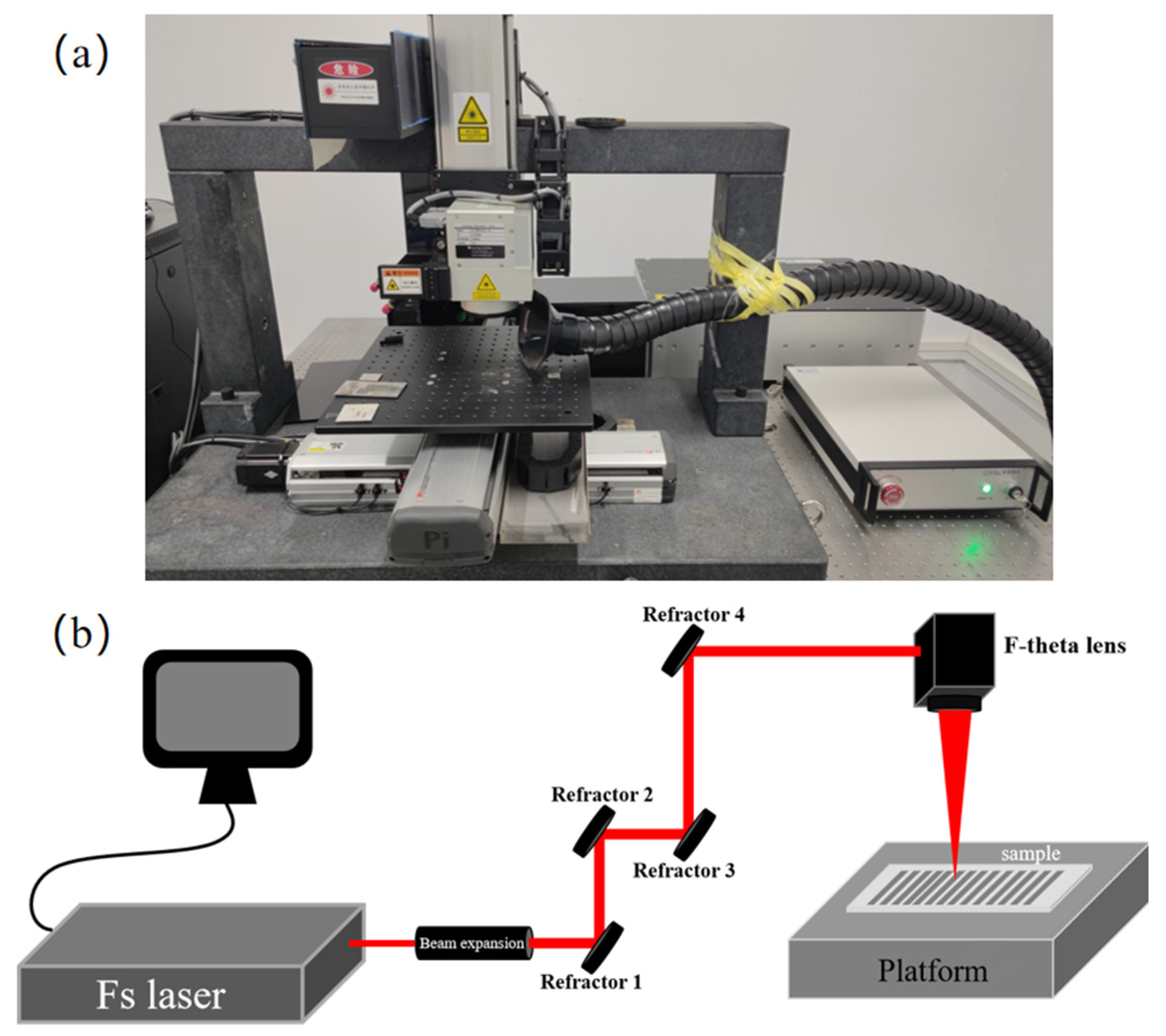
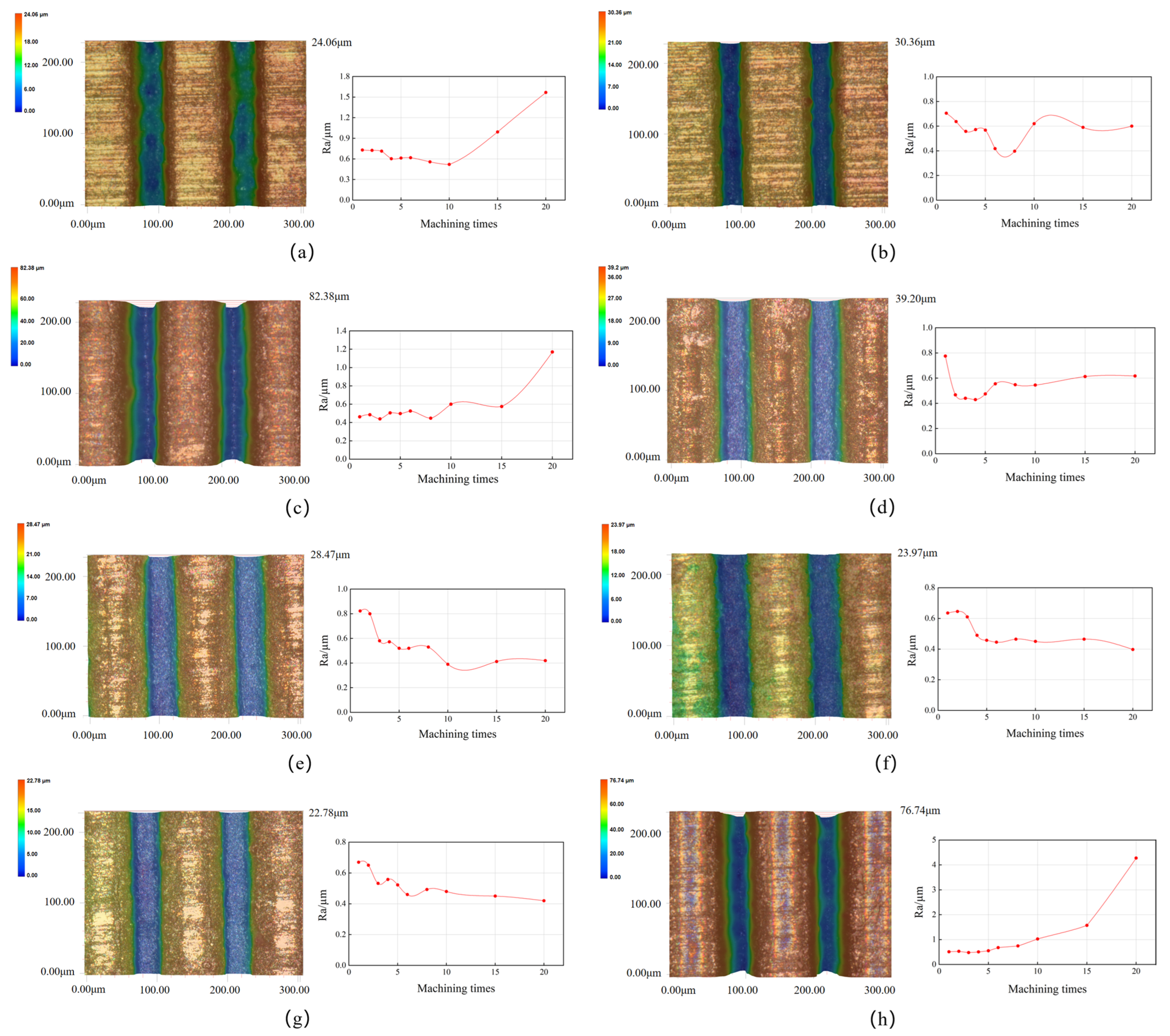
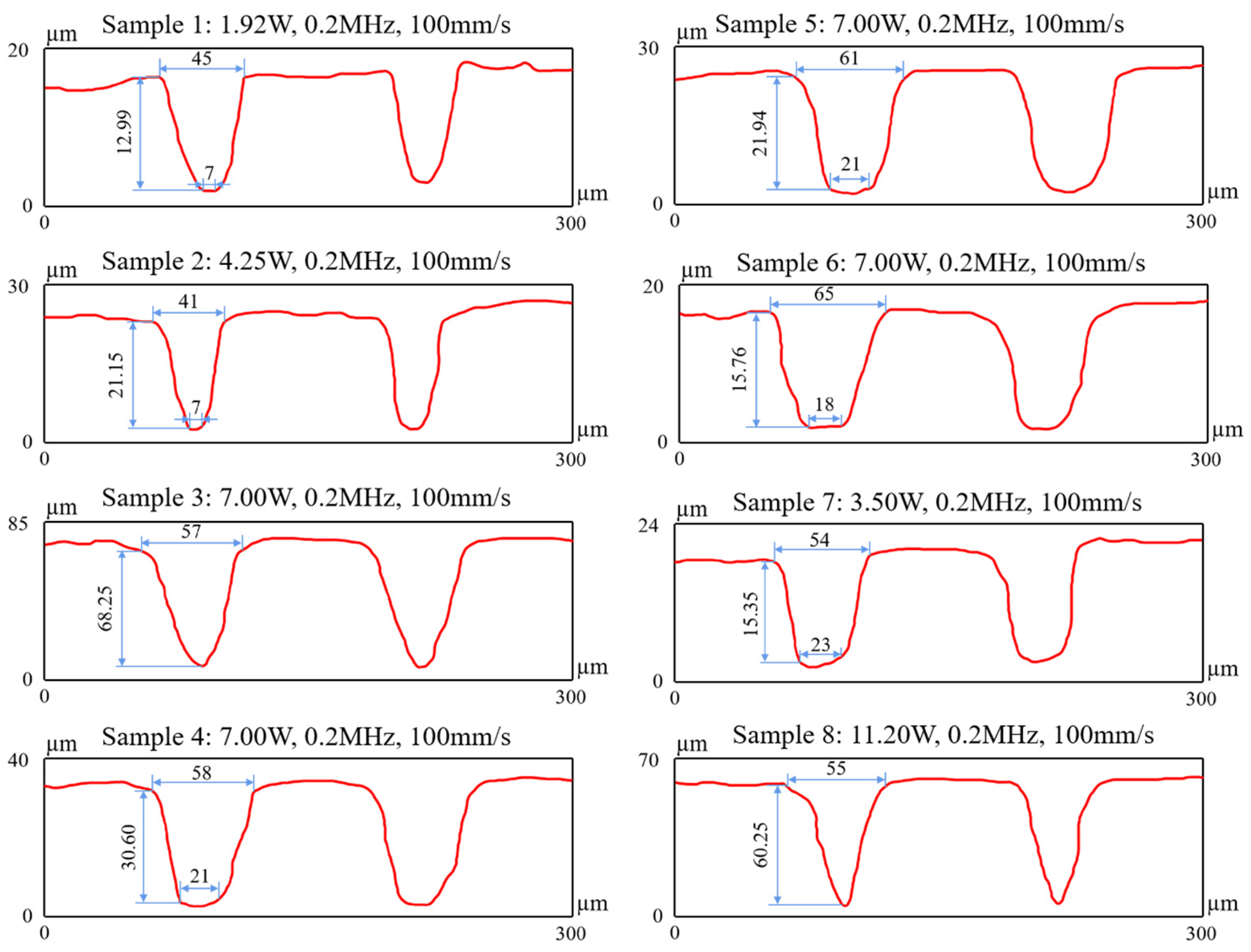
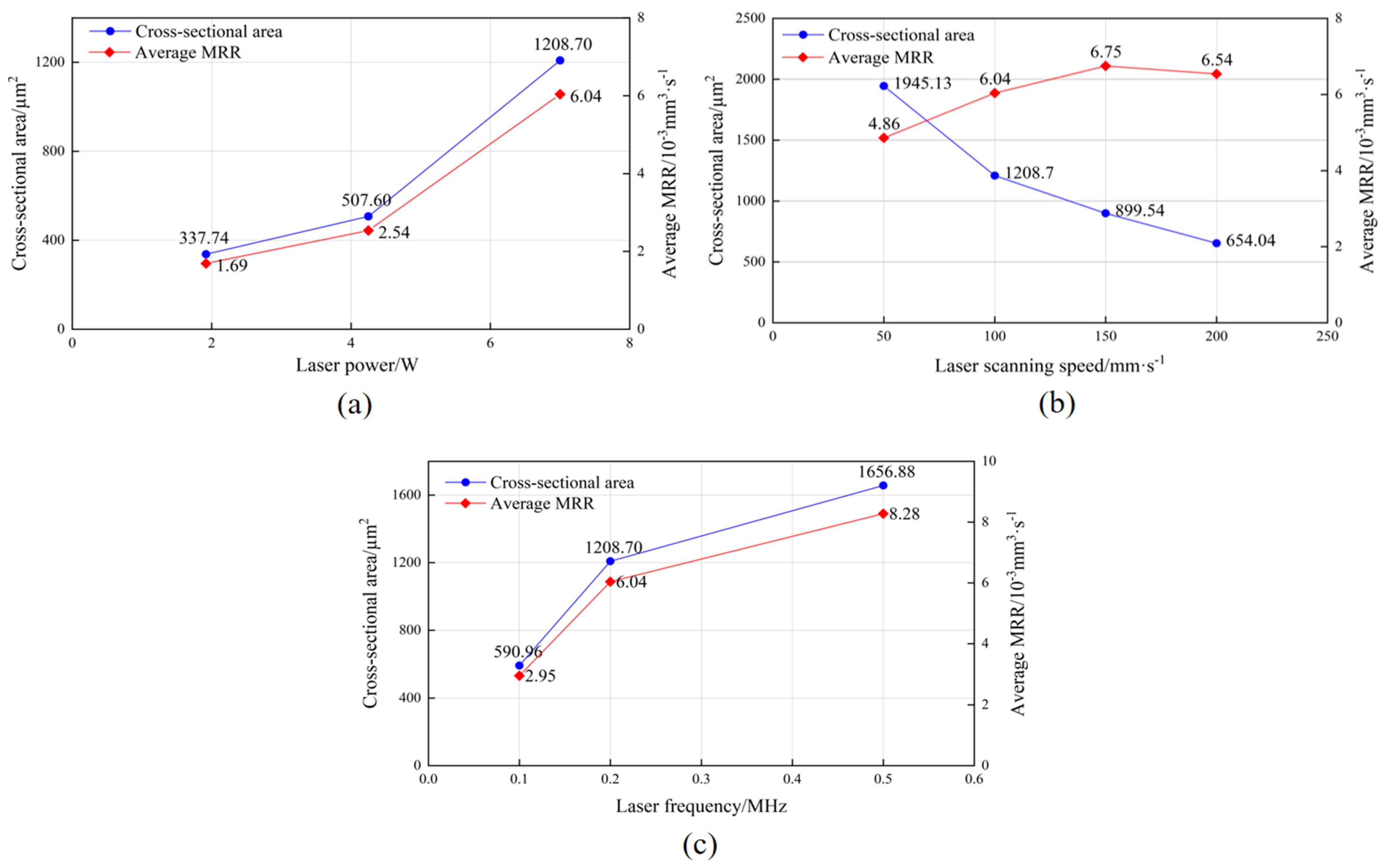
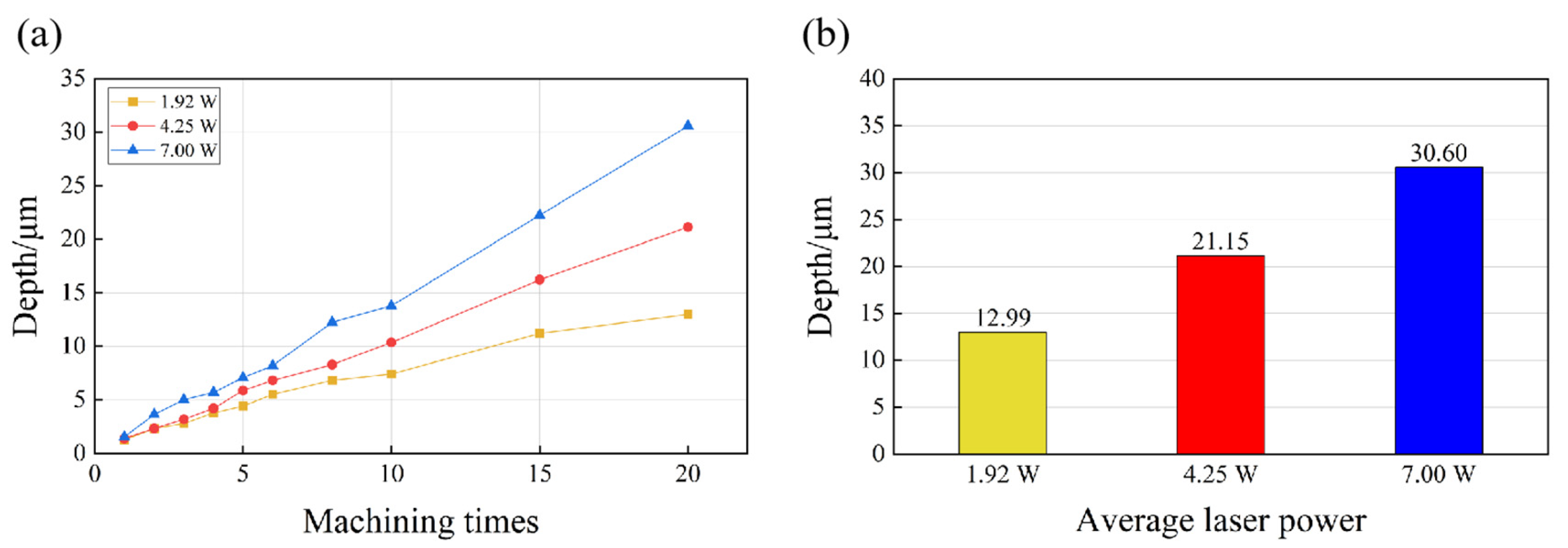
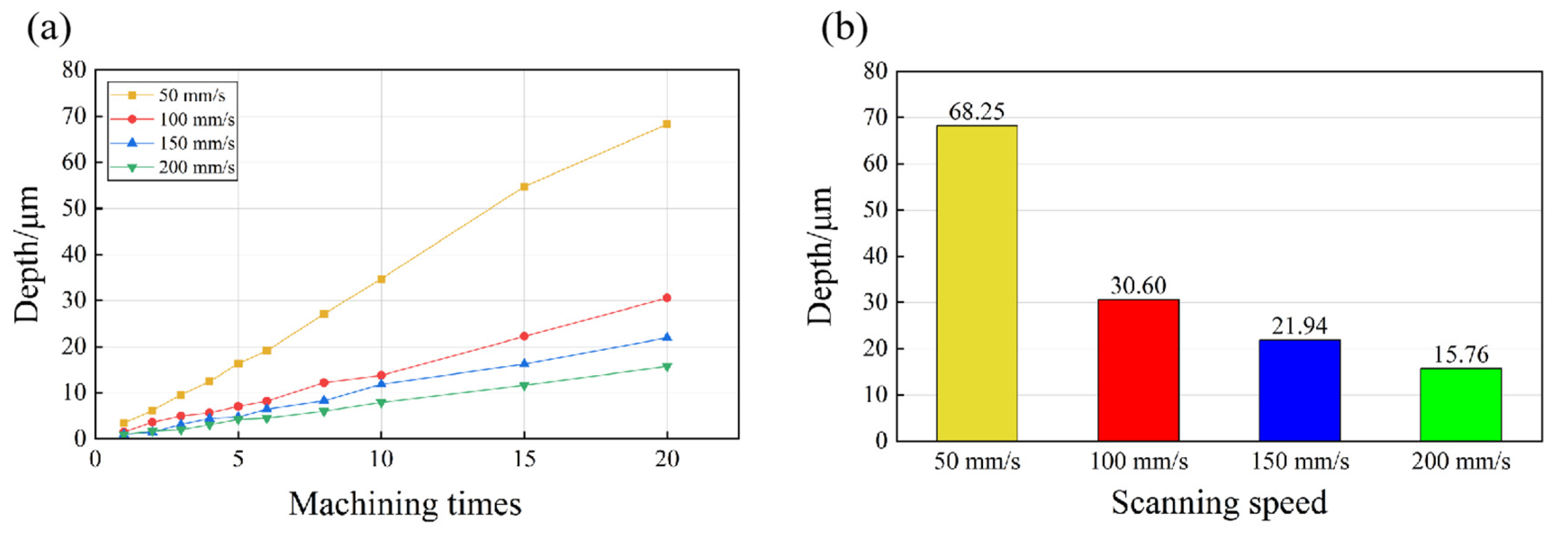

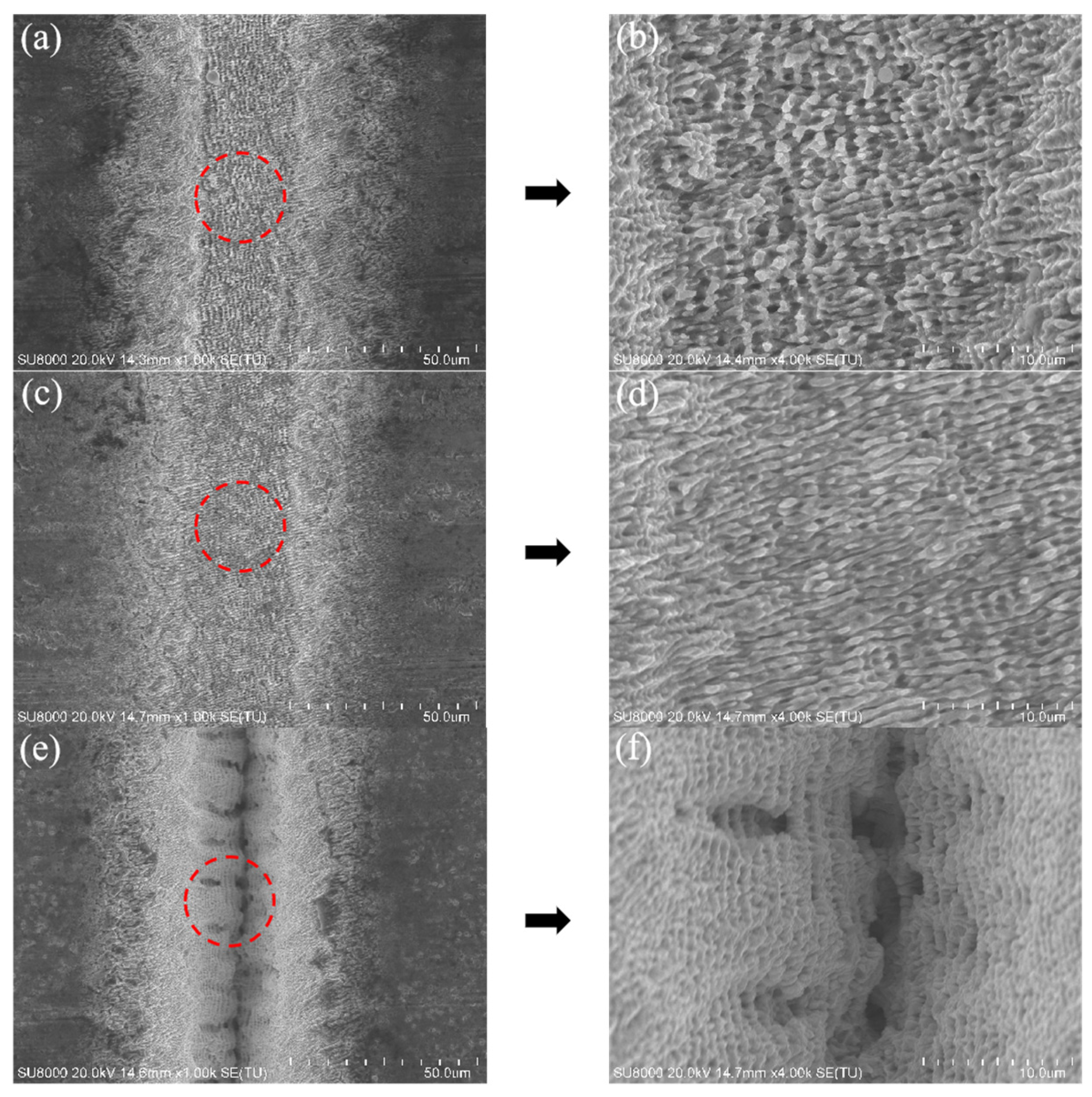
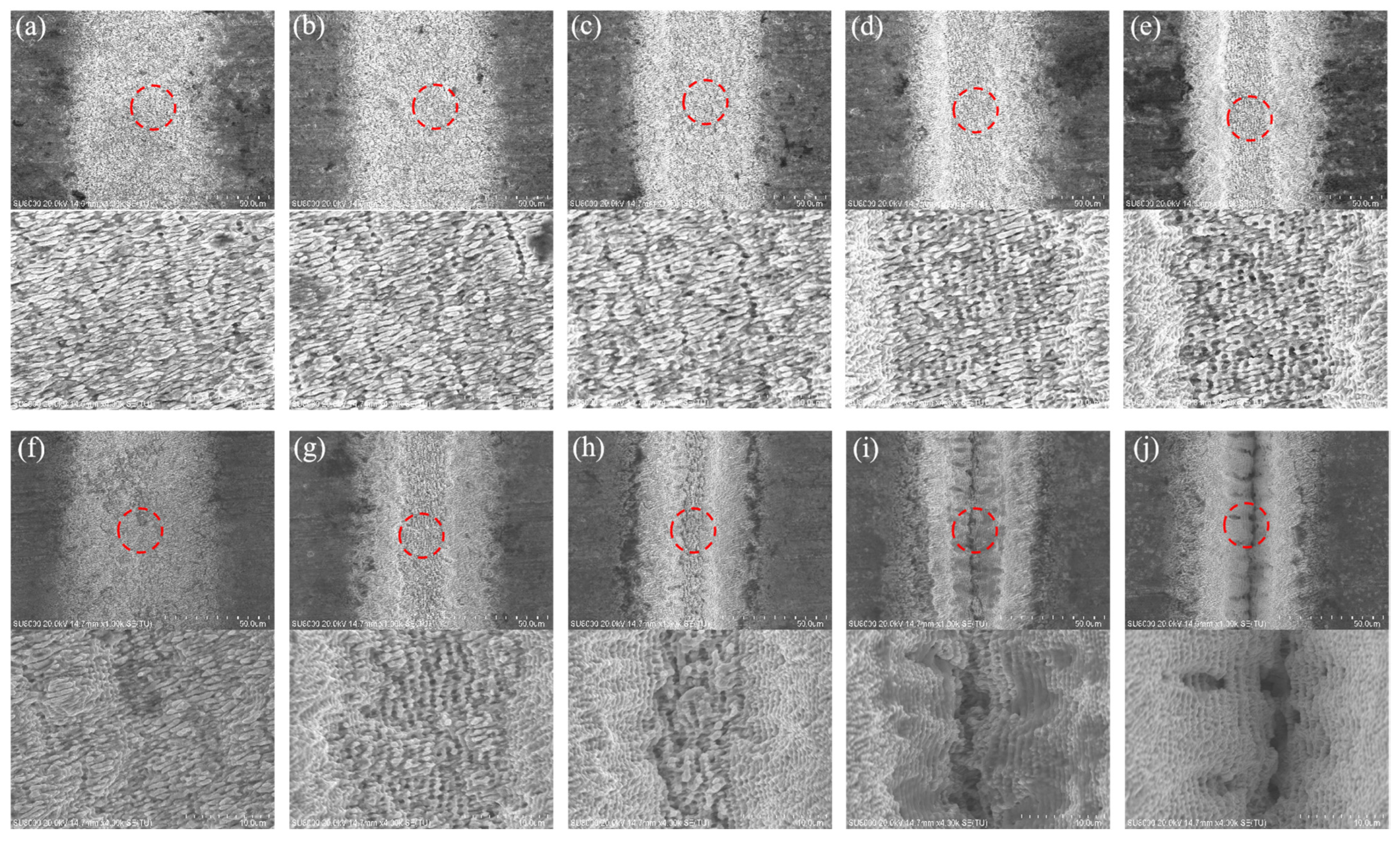
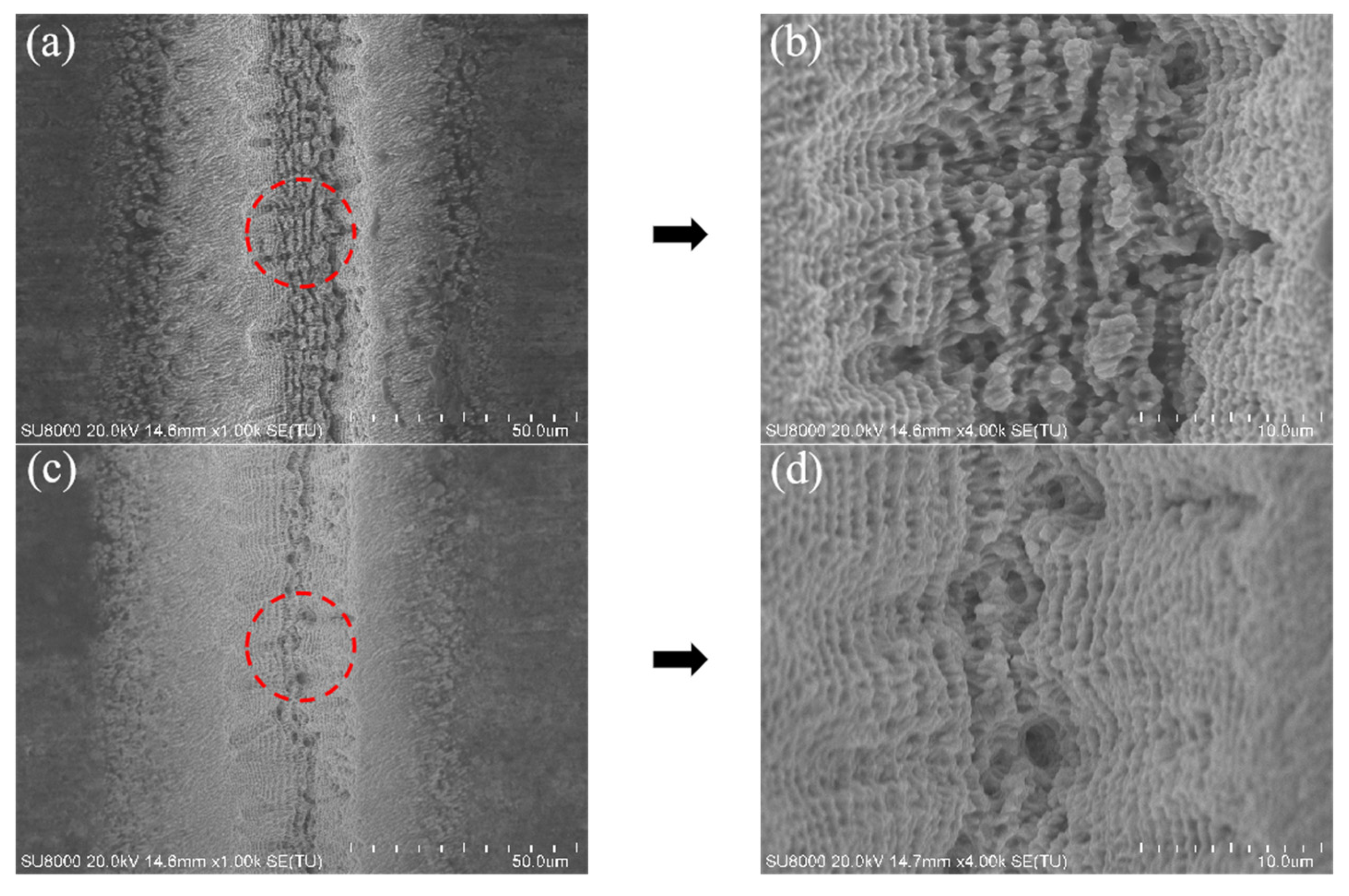
| Parameter | Unit | Numerical Value |
|---|---|---|
| Density | g cm−3 | 12.4~13.5 |
| Hardness | — | 90.5 |
| Bending strength | MPa | 1350 |
| Young’s modulus Thermal conductivity | GPa W/(m·K) | 700 20~50 |
| Chemical Composition | Percentage (%) |
|---|---|
| WC | 84 |
| TiC + TaC | 10 |
| Co | 6 |
| Parameter | Numerical Value |
|---|---|
| Central wave length (nm) | 1030 |
| Pulse width (fs) | 300 |
| Repetition frequency (kHz) | 25~5000 |
| Beam quality | M2 < 1.3 |
| Sample No. | Average Laser Power (W) | Laser Frequency (MHz) | Scanning Speed (mm/s) | Ablation Cycles for the Measurement |
|---|---|---|---|---|
| 1 | 1.92 | 0.2 | 100 | 1, 2, 3, 4, 5, 6, 8, 10, 15, 20 |
| 2 | 4.25 | 0.2 | 100 | |
| 3 | 7.00 | 0.2 | 50 | |
| 4 | 7.00 | 0.2 | 100 | |
| 5 | 7.00 | 0.2 | 150 | |
| 6 | 7.00 | 0.2 | 200 | |
| 7 | 3.50 | 0.1 | 100 | |
| 8 | 11.20 | 0.5 | 100 |
| Sample No. | Cross-Sectional Area (µm2) | Average MRR (10−3 mm3/s) |
|---|---|---|
| 1 | 337.74 | 1.69 |
| 2 | 507.60 | 2.54 |
| 3 | 1945.13 | 4.86 |
| 4 | 1208.70 | 6.04 |
| 5 | 899.54 | 6.75 |
| 6 | 654.04 | 6.54 |
| 7 | 590.96 | 2.95 |
| 8 | 1656.88 | 8.28 |
Disclaimer/Publisher’s Note: The statements, opinions and data contained in all publications are solely those of the individual author(s) and contributor(s) and not of MDPI and/or the editor(s). MDPI and/or the editor(s) disclaim responsibility for any injury to people or property resulting from any ideas, methods, instructions or products referred to in the content. |
© 2023 by the authors. Licensee MDPI, Basel, Switzerland. This article is an open access article distributed under the terms and conditions of the Creative Commons Attribution (CC BY) license (https://creativecommons.org/licenses/by/4.0/).
Share and Cite
Li, G.; Li, X.; He, G.; Fan, R.; Li, F.; Ding, S. Surface Quality and Material Removal Rate in Fabricating Microtexture on Tungsten Carbide via Femtosecond Laser. Micromachines 2023, 14, 1143. https://doi.org/10.3390/mi14061143
Li G, Li X, He G, Fan R, Li F, Ding S. Surface Quality and Material Removal Rate in Fabricating Microtexture on Tungsten Carbide via Femtosecond Laser. Micromachines. 2023; 14(6):1143. https://doi.org/10.3390/mi14061143
Chicago/Turabian StyleLi, Guangxian, Xuanang Li, Guichao He, Ruiguang Fan, Feiyuan Li, and Songlin Ding. 2023. "Surface Quality and Material Removal Rate in Fabricating Microtexture on Tungsten Carbide via Femtosecond Laser" Micromachines 14, no. 6: 1143. https://doi.org/10.3390/mi14061143
APA StyleLi, G., Li, X., He, G., Fan, R., Li, F., & Ding, S. (2023). Surface Quality and Material Removal Rate in Fabricating Microtexture on Tungsten Carbide via Femtosecond Laser. Micromachines, 14(6), 1143. https://doi.org/10.3390/mi14061143








